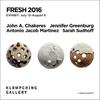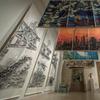Artist Giuseppe Penone Makes Important Gifts of Hundreds of Drawings to Philadelphia Museum of Art and Centre Pompidou, Paris
- PHILADELPHIA, Pennsylvania
- /
- June 17, 2020
"A drawing is both the tracing of a person’s hand, and it is the imprint of a thought. This group of drawings is a journey through the ideas that have nourished my work." - Giuseppe Penone
Internationally acclaimed sculptor Giuseppe Penone (born, Italy, 1947) has made two extraordinary gifts of works on paper and artist books—created throughout a remarkable five-decade career and documenting its many important phases—one each to the Philadelphia Museum of Art and to the Centre Pompidou in Paris. An artist whose practice originally aligned with the Arte Povera group from the late 1960s, Penone has developed an outstanding body of work ranging from performative actions and sculptures to works on paper. His practice focuses primarily on the redefinition of sculpture through the connections between nature and culture, understood as interdependent entities reciprocally defined. The gifts to the two institutions total more than 660 works in all.
The artist’s gift to Philadelphia, encompassing 309 works on paper and 5 artist books, includes a large number of works that have never been exhibited or reproduced before and constitutes a significant portion from the artist’s entire corpus of works on paper, which spans from the late 1960s until today. These drawings display a wide variety of techniques and motives and represent a comprehensive sample from his entire œuvre. Penone made the gift in honor of his wife, Dina Carrara. The museum is planning a special exhibition and publication dedicated to Penone’s drawings in 2022.
Timothy Rub, the George D. Widener Director and CEO of the Philadelphia Museum of Art, said: “Penone’s entire production interrogates the connection between the individual and the natural world. This wonderful gift, ranging from individual drawings and two portfolios to five editioned books, perfectly encapsulates the artist's practice from the 1960s to the present day. This is a spectacular addition to our collection of contemporary art, and we are deeply grateful to the artist.”
Drawing is central to the artist’s practice, and the gift to Philadelphia encapsulates the artist’s modus operandi from the 1960s to present day. This wide selection reflects Penone’s impressive range of techniques and materials (pencil, biro, watercolor, coffee, India ink, frottage, graphite, rice paper, cardboard, Japanese paper, glossy paper treated with turpentine, charcoal, adhesive tape, and leaves) and traces his explorations of skin as the organic threshold between the self and the natural world. Some works, from the late 1960s to the early 1970s, are preparatory drawings for future installations or sculptures. Drawings such as Progetto per la mostra da G. Enzo Sperone (Project for the Exhibition at G. Enzo Sperone), 1969, appear as quick impressions on paper accompanied by written instructions. Another thread of works stands as part of related sculptures or interventions. For example, Progetto per lenti a contatto specchianti – Guardare la strada (Project for mirroring lens – to look at the street), 1970, could be viewed as a continuation of his iconic Rovesciare i propri occhi (To Unroll One’s Eyes), 1970. Finally, some drawings are autonomous works, such as the stunning Scultura (Sculpture), 1974, ten sheets of cardboard carrying the imprint of the skin in graphite on adhesive tape that resemble thin branches or tangled spider webs, spreading over the paper support.
Prior to this gift, the Philadelphia Museum of Art owned two works on paper by Penone. The remarkable addition of drawings, portfolios, and editioned books makes the museum the most significant repository of Penone’s drawings in the United States. The gift builds upon the museum's ongoing engagement with Postwar and contemporary Italian art, including recent acquisitions of works by Arte Povera artists Marisa Merz and Michelangelo Pistoletto as well works by others of the same period such as Fabio Mauri and Dadamaino.
Carlos Basualdo, the museum’s Keith and Katherine Sachs Senior Curator of Contemporary Art, commented: “This group of drawings allow us both to trace the evolution of Penone’s work from the late 1960s until today and to grasp its rigorous logic. Penone thinks through his drawings and this selection constitutes an extraordinary map of his imagination.”
Penone and the Centre Pompidou
The close ties between Giuseppe Penone and the Centre Pompidou have been longstanding, and the donation by Penone of some 350 drawings from the period of 1967 until 2019 to the Cabinet d’art graphique at the Centre Pompidou constitutes a new major contribution. In the 1970s, Penone witnessed the establishment of the Centre Pompidou, marking the beginning of an enduring relationship. In 2004, the Centre Pompidou dedicated a retrospective exhibition to the artist. Today, the Musée National d’Art Moderne (NMAM) at the Centre Pompidou contains almost 30 of his works in its collection and two rooms are now devoted to him in its permanent exhibition galleries. Penone’s drawings go hand-in-hand with his written texts (his philosophy of art, studio notes, and poetic texts) which the Paris School of Fine Arts compiled in 2000 in one volume, and which has been regularly re-edited and added to under the title Respirer l’ombre (Breathe the Shadow), the same title as the masterful installation in the collection of the NMAM. In 2017, three large sculptures by Penone were added to the Centre Pompidou collection. In a world currently in upheaval, his work appears as something of a patient meditation, both subtle and obstinate, on time and its place in the space of the work. At the Centre Pompidou, the exceptional gift will be the subject of an exhibition in 2022.
About Giuseppe Penone
Currently based in Turin, Italy, Giuseppe Penone was born in the village of Garessio in the northern region of Piedmont. His rural upbringing greatly influenced his pioneering practice. He intended his groundbreaking performances and sculptures of the1960s and 1970s to be interventions, placing his body in close contact with nature, particularly trees, stones and water. Penone’s entire oeuvre interrogates the connection between the human being and the natural world, approaching nature as an autonomous, animated organism that corresponds with the workings of the human body. While sharing with Arte Povera the common goals of bridging art and everyday life, Penone's emphasis on the use of his body in his work and his interest in nature has also aligned him with other artistic movements, such as Process Art and Land Art.
Penone's work is contained in prominent international public collections such as the Museum of Modern Art (New York), Tate Modern, (London), Nationalgalerie (Berlin), MAXXI (Rome), and the Centre Pompidou (Paris), which organized a retrospective exhibition of his work in 2004. Major exhibitions include Penone. L’Espace de la main, (curated by Roland Recht, Michele Lavallée and Jonas Storsve, Ancienne Douane, Strasbourg, 1991-1992); Giuseppe Penone, Kunstmuseum, Winterthur, 2013); Penone Versailles, 2013; and Giuseppe Penone. A tree in the wood (Yorkshire Sculpture Park, 2018 - 2019).
Penone was the recipient of the 26th Praemium Imperiale award in sculpture in 2013. Additionally, he was honored with a site-specific commission, titled Germination, for the Louvre Abu Dhabi on the occasion of its opening in 2017.















![Peter Paul Rubens (Flemish, 1577–1640), After Titian (Tiziano Vecelli) (Italian [Venetian], c. 1488–1576), Rape of Europa, 1628–29. Oil on canvas, 71 7/8 x 79 3/8 in. Peter Paul Rubens (Flemish, 1577–1640), After Titian (Tiziano Vecelli) (Italian [Venetian], c. 1488–1576), Rape of Europa, 1628–29. Oil on canvas, 71 7/8 x 79 3/8 in.](/images/c/e2/2e/Jan20_Rape_of_Europa100x100_c.jpg)
